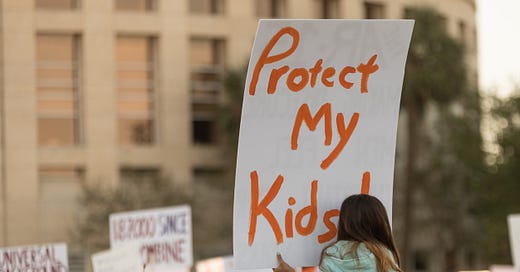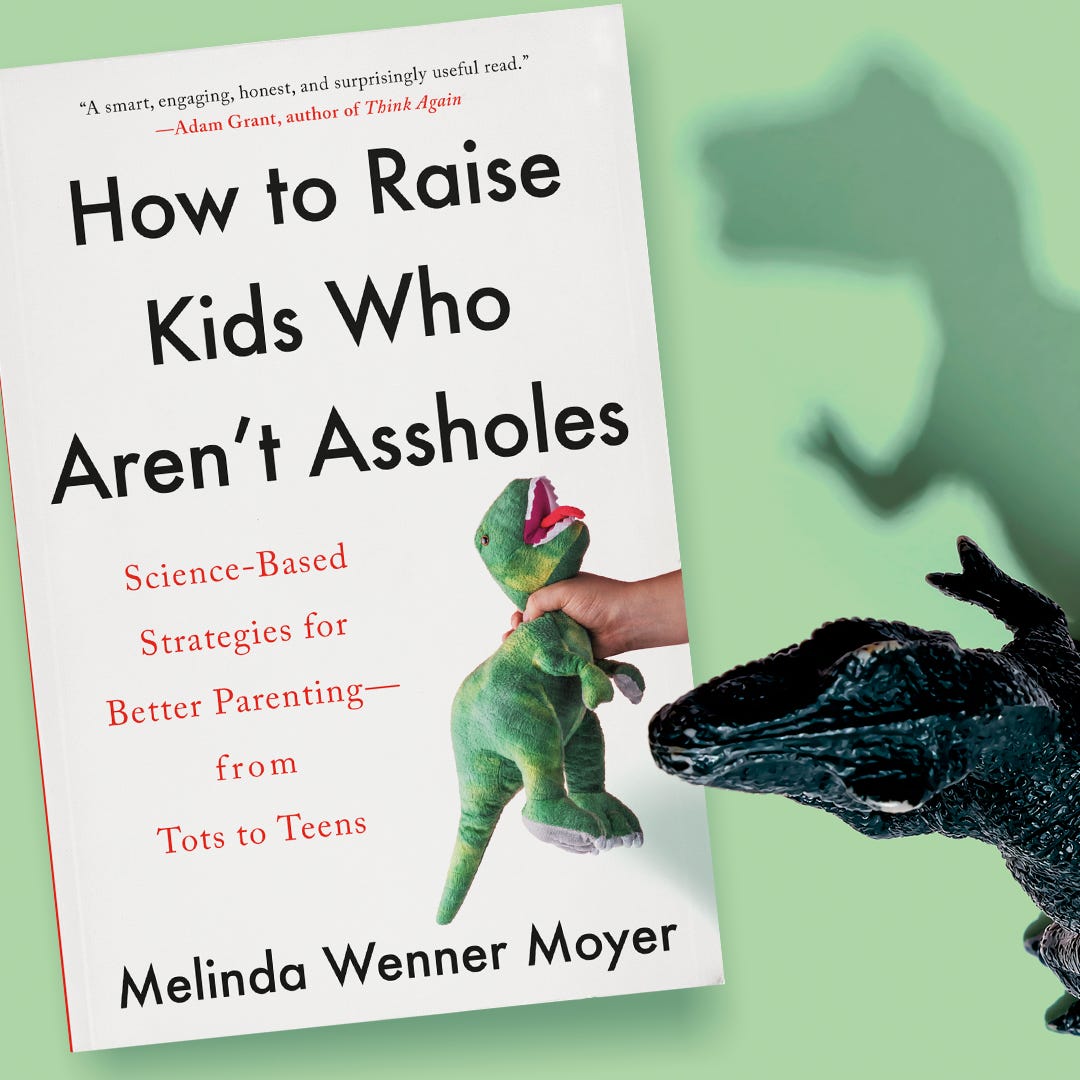Hi everyone! I’m sorry that this newsletter is two days late. I’m behind on a lot of things, largely because my kids have only been in school for approximately 40 seconds over the last three weeks, thanks to our bout with Covid-19 and holiday weekends. Also, the world is a dumpster fire and it’s been hard to stay focused.
Yet focus right now is what we desperately need. What happened in Uvalde last week was horrific, heartbreaking, and infuriating, not least because it was entirely preventable. Since 2020, gun violence has been the number one leading cause of death among children and teens in the United States. Teens and young adults are 43 times more likely to be murdered with a gun if they live in the U.S. compared with other developed countries — and that’s because of how we, as a country, sell and regulate (or shall I say don’t regulate?) guns.
One of the scariest things about school shootings is that they feel completely out of our control. How can we protect our kids from random strangers who open fire in their classes? An important thing to keep in mind, though, is that more than 99 percent of children who die by gun violence in the U.S. are not shot in random school shootings. And there are things we can do to keep our children safe from all forms of gun violence. Here’s what the science suggests.
1. Keep guns out of your home.
The best way to keep your kids safe from guns is to keep guns out of your home. This isn’t just my opinion; the American Academy of Pediatrics says the same thing. I know that owning a gun might seem like a good idea — won’t it help you defend your family against intruders? — but I spent months looking at the data and interviewing researchers for a story I wrote on this question for Scientific American, and sadly, the research suggests the opposite. A gun at home actually puts you at increased risk. One study found that guns at home were four times more likely to cause an accidental shooting, seven times more likely to be used in assault or homicide, and 11 times more likely to be used in a suicide than they were to be used for self-defense.
About those popular claims by the NRA that guns are often successfully used in self-defense: They’re really not. In one study, researchers at Harvard and the University of Vermont analyzed data from the National Crime Victimization Survey (NCVS), which is conducted in tens of thousands of U.S. households. They found that guns are used for self-defense in less than 1 percent of all crimes that occur in the presence of a victim. They also found that self-defense gun use is about as effective as other defensive maneuvers, such as calling for help.
2. If you do have guns, lock them away unloaded, with the ammunition locked separately.
Among kids under the age of 13, nearly half of all gun injuries and deaths are accidental. There are so many unintentional shootings in part because an estimated 4.6 million American children live in homes where at least one gun is unlocked and loaded — and kids can find these guns and play with them.
You might assume that your kids don’t know where you keep your guns, but research suggests otherwise. More than three-quarters of kids — even young ones under the age of 10 — know where parents store their firearms, even when parents don’t think they do. In a 2021 study, researchers interviewed teens and parents and found that in households where parents said their teen could not access a firearm, more than one-fifth of the teens not only disagreed but said that actually, they could get their hands on their parent’s loaded gun in less than 5 minutes.
It’s also not true that you can eliminate risk by educating kids about guns, which is something the NRA regularly touts. As I wrote in Slate a few years ago:
Certainly, talking to them about guns — how dangerous they are, why they should never be played with — is not a bad idea, but it’s simply not enough. Marjorie Sanfilippo, a psychologist at Eckerd College in Florida, has conducted a series of terrifying experiments illustrating that boys and girls simply don’t listen when you warn them about guns. In her first study, published in 1996, she let pairs of 4- to 6-year-old children play in a room with various toys including real and toy guns. Then she and a local police officer spent 30 minutes educating one of the children in each pair about the dangers of guns — among other things, that they are never to be touched without a parent’s permission and that kids should always find an adult if they come across one.
A week later, she put the pair of children back together in the same room again to play.
“What we found is that the children who had the lessons played with the guns just as much as the children who didn’t — and they didn’t leave the area to get an adult, and they didn’t stop the friend from playing with it. It was as if they’d gotten no lessons whatsoever,” she recalls. In a subsequent experiment, she enrolled one group of preschool children in a weeklong firearm-education session while another group of kids had no training. Again, the intervention had no effect on the children’s likelihood of playing with guns. “There’s no amount of teaching that can overcome that natural curiosity about guns,” she concludes.
Unsecured guns are also more likely than secured guns to be stolen, putting them in the hands of people who might commit violent crimes. And unsecured guns increase the risk for child suicide. Research published in 2019 found that three-quarters of all firearm suicides among youth occurred in homes where firearms were stored unlocked and loaded.
3. When your kids go to friends’ houses, ask the parents how they store their guns.
It’s not enough to ensure your own home is safe — you also need to ensure that your kids are safe at other people’s houses. One study found that 19 percent of kids under 14 who died from an accidental shooting were killed at friends’ homes.
Wondering how to ask this awkward question? Here’s some advice from my Slate piece:
If the thought of posing this question makes you uneasy — maybe you worry about offending the other person — consider that “people who own guns are often more comfortable having these conversations than people who don’t,” says Jennie Lintz, director of public health and safety at the nonprofit Brady Center to Prevent Gun Violence. If you still feel weird, try it this way: “Call the parent and say, ‘My son is fascinated with guns — he’s going through a phase — so I just want to make sure that you don’t have any real guns accessible.’ Because then you’re saying, ‘I want to protect your child, too,’ ” Sanfilippo says. If guns aren’t stored in a way that makes you comfortable, invite the child over to your home instead.
4. Advocate for laws that protect kids (and vote for politicians who support them).
There are a lot of proposed gun safety laws out there, and it can be hard to know which ones to push for the most. Research on gun safety is still in its infancy, in part because the NRA has made it very hard for researchers to conduct it, but studies suggest that some laws are more effective than others, and that different kinds of laws protect against different kinds of gun violence. A few years ago, for instance, I wrote about four laws that research suggests can reduce the risk of mass shootings. Here, I’m going to share the two kinds of laws that have been shown to best protect children and teens.
Child Access Protection (CAP) laws. These laws, which allow authorities to criminally charge adults who intentionally or accidentally grant children unsupervised access to firearms, are among the most most effective gun policies we have. In 2020, I wrote about an important systematic review of 123 studies that found that CAP laws significantly reduce self-inflicted firearm injuries and deaths among kids and teens. Among other things, states with stronger CAP laws have fewer pediatric firearm injuries than states with weak CAP laws.
Safe storage laws, which require gun owners to store their guns unloaded and locked when unattended, are form of CAP law, but only a handful of states have safe storage laws. (Massachusetts has the most stringent law.) One study found that in states with safe storage requirements, accidental shooting deaths among children were almost a quarter lower than in states without these requirements.
If you’re wondering if your state has a CAP law (including a safe storage law), here's an up-to-date list. If your state doesn’t have one, call your Congressional representatives and communicate your support for them. (And if you’re curious just how much money your Senators have taken from the NRA, check out this chart.)
Minimum Age for Purchase Laws. Although Federal law restricts the sales of handguns to people over 21, teens as young as 18 can buy rifles and long guns unless they live in a state with stricter regulations. The 18-year-old Uvalde shooter legally purchased his guns in the days before his attack.
We need more research on how raising the minimum age of gun purchases affects the overall risk for youth gun violence. But the systematic review I mentioned earlier concluded that stricter minimum age requirements lower the risk of teen firearm suicide, and this is important considering that teen suicide has been increasing, especially among youth of color.
This brings up a very important point: The vast majority of kids and teens who are harmed by guns (including in schools) are Black youth who live in urban areas. There are undoubtedly many systemic factors at play, including racism and a serious underinvestment in Black communities. We need to make many, many systemic changes to better serve families of color and reduce the toll of gun violence in their communities. But better gun laws are one step that would help.
If you’re feeling numb right now in light of all the terrible news, but you don’t want to disengage, read my New York Times Well newsletter from last week on the common phenomenon known as “psychic numbing” and what you can do to overcome it.
If you want to hear more about the bizarre experience my family had with Covid-19 recently and what experts thought about it, be sure to read tonight’s Well newsletter, too. Subscribe here.
The paperback of my book How To Raise Kids Who Aren’t Assholes comes out in less than three weeks, on June 21! I’m very excited. You can pre-order it anywhere books are sold. (If you don’t want to wait, buy the hardback, which is available now.)







Thanks for this post! Super helpful.